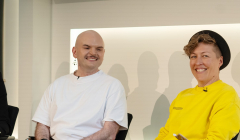
‘There is a climate of fear for marketers’
Industry leaders urged brands to transition from caution to courage at Courageous Leaders Live

Claire Gillis, International CEO, WPP Health Practice on why, if we’re serious about employee wellbeing, we must cement it as a boardroom priority and create metrics that prove its unquestionable value.

It’s a management principle that transcends the ages: ‘if you can’t measure it, you can’t improve it’. The theory has served industry well, creating a metrics-led culture that continues to drive growth. So why do we still struggle to measure performance in one of the most important challenges we face: protecting mental wellbeing at work?
With more and more people experiencing mental health issues in the workplace, we know we must do better. But how can you fix a problem if you don’t understand its nature and scale? And how you do you know your efforts are working if you can’t even see the baseline position? It’s time we moved beyond guesswork.
Don’t get me wrong, mental wellbeing is on the radar of all employers, as evidenced by the array of initiatives businesses are introducing to alleviate workplace stress. However, without being able to measure their real-world impact, there’s a danger these initiatives look purely cosmetic. If we’re serious about employee wellbeing, we must cement it as a boardroom priority and create metrics that prove its unquestionable value.
Business’s quest to build shareholder value has journeyed through distinct cycles. In the 1990s, it was all about financial value: the hard economics of profit and growth. In the 2000s, attention moved to ‘societal value’: sustainability and CSR. Today, focus is rightfully shifting onto the value of ‘human capital’: how can we look after our people? Leaders are recognising that, in the battle to attract and retain talent, corporate culture and employee wellbeing strategies are key drivers of competitive advantage. It’s a start. But we must push harder to put workplace wellness on CEOs’ agendas everywhere.
History tells us that numeration is often the best way to grab the c-suite’s attention so here’s a cold shower of numbers to wake us all up. Depression and anxiety costs the global economy an estimated $1 trillion each year in lost productivity. A third of adults have suffered mental health problems at work, with almost half never disclosing it to management. In the UK alone, mental health issues cost employers over £40 billion a year in staff turnover, absenteeism and presenteeism, with disengaged or stressed workers quietly influencing culture, productivity and profitability. And if the financial costs are significant, the human implications are even worse.
However, while the impact of mental health problems at work is crystal clear, the effectiveness of strategies designed to address them sadly isn’t. We need better metrics. It’s the difference between ticking the box and thinking outside of it; between saving money and saving lives.
Engagement goes beyond the annual survey; it’s there in employees’ everyday experiences.
Claire Gillis
One widely adopted measure is employee engagement surveys. These examine workplace ‘hygiene factors’, offering insight into employee satisfaction and the triggers of stress or discontent. Engagement surveys are a great way of benchmarking progress and identifying pain-points. However, they can be open to unintentional bias. Critics argue that employees’ desires to present themselves in a positive light means that surveys can become exercises in ‘impression management’ rather than tools for change. Survey design is everything.
Make no mistake, employee engagement surveys are a fantastic start point but we must build on them to progress to the next level. Fundamentally, engagement goes beyond the annual survey; it’s there in employees’ everyday experiences. Good, bad or indifferent, we’re engaging all the time. In my own organisation, our wellbeing programme includes opportunities for weekday yoga, group therapy and one-to-one counselling with our in-house therapist. Initiatives are well-supported, well-liked and, in many areas, over-subscribed. These are good top-line measurements, but they’re not enough. Effective measurement i.e. is this working? must be real-world and real-time.
So, we’ve turned to technology for help. We’re working with our teams to pilot wearable tech from BioBeats that captures workers’ physiological and psychological data and uses it to generate personalised insights that can help them reduce stress. The device monitors heart rate, activity and respiration, baseline markers of anxiety, providing real-world clues to mental health. The data is anonymised, aggregated so we can use it to see how our environments are affecting workplace wellbeing. We then apply behaviour science, and our expertise in health and creative communications, to develop mental health support at scale. Everyone wins.
Technology will inevitably play a crucial role in improving mental wellbeing at work, providing opportunities to wrap real-world metrics around an important issue that’s for too long been addressed by guesswork. With mental illness a global epidemic, the time for guessing is over. If we’re serious about employee wellbeing, we must develop better metrics. After all, if we can’t measure it, we can’t improve it.
With a foundation as a pharmacologist and health economist, Claire founded a specialist medical access consultancy called WG Group in 1996. In 2010, WG Group was bought by WPP, enabling Claire to continue her leadership and vision by successfully establishing the WG Group in the US. In 2016 she was promoted to International CEO of WPP Health Practice, leading some of WPP’s flagship health brands including Ogilvy Health and Sudler in the UK, France, Spain, Italy, Germany, China, Japan, and Australia. Medical practitioner, health economist, entrepreneur and business leader, Claire is passionate about using communications to promote better access to healthcare and is a regular industry commentator across publications including Adweek, MM&M and The Drum. She is the inaugural winner of Women in Marketing’s “Best Marketing Leader in Creating Change in Health and Wellness” award.
Looks like you need to create a Creativebrief account to perform this action.
Create account Sign inLooks like you need to create a Creativebrief account to perform this action.
Create account Sign in